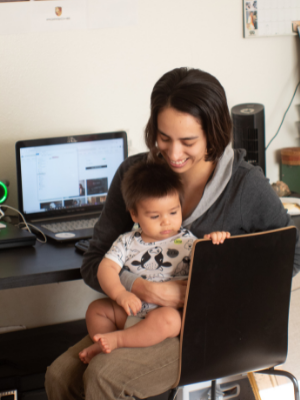Mother’s Day: Tasks at Home and Work that Hold You Back
 As we aim to reduce inequities in pay in the workforce, we need to focus not only on how men and women spend their time at work but also how household duties are divided at home. Research shows that women who have male partners and work outside the home handle more tasks at home. A study by Oxfam and the Institute for Women’s Policy Research looked at the amount of time women and men in the US spend on unpaid labor in the home. Women who work full-time outside the home spend almost 5 hours a day on unpaid work at home compared with about 4 hours for men. If you are one of the women who picks up the slack, this is unlikely to surprise you. Data on the division of household tasks suggest that people in same-sex relationships divide household tasks more equally than those in opposite-sex households.
As we aim to reduce inequities in pay in the workforce, we need to focus not only on how men and women spend their time at work but also how household duties are divided at home. Research shows that women who have male partners and work outside the home handle more tasks at home. A study by Oxfam and the Institute for Women’s Policy Research looked at the amount of time women and men in the US spend on unpaid labor in the home. Women who work full-time outside the home spend almost 5 hours a day on unpaid work at home compared with about 4 hours for men. If you are one of the women who picks up the slack, this is unlikely to surprise you. Data on the division of household tasks suggest that people in same-sex relationships divide household tasks more equally than those in opposite-sex households.
There are things you can do to lighten your load. Talk with your family about how communities and societies function best when everyone shares equitably in the work. List all your household’s chores and who currently does them. If they’re not assigned equally, then reassign tasks to the family members capable of doing them. Relieving yourself of an excessive workload at home matters because our research shows that you may not be overloaded only at home. As previously written on theglasshammer, women are subject to a double whammy of doing more of the thankless tasks at home in addition to more non-promotable tasks (NPTs) at work.
Non-promotable tasks help organizations move forward in a myriad of ways, but they come with a catch—they don’t necessarily benefit the person who does them. While it is important to help co-workers, organize events, or make presentations look great, no one gets a raise or a promotion for doing unrewarded work. Our research definitively shows that women are much more likely to do these tasks, and that this shrinks their potential for advancement. Their organizations suffer too. When women handle the non-promotable work, their organizations forfeit the contributions women could be making to the bottom line.
We want to change that, and here are five ideas you can use to free yourself (and your female colleagues) from this dead-end work. These changes will help not only you, but also your organization!
- Determine how much non-promotable work you should do. Start by identifying the non-promotable work that you currently do. Learn what your organization values for its growth and for your career advancement. Those activities, the promotable tasks, are where you should spend most of your time. You’ll still need to do some non-promotable work, but you don’t want to do too much. Start discussing NPTs with your co-workers. What type of NPTs are they doing, and how much time are they spending on them? Your goal is to have a load that is similar to that of your peers—women and men.
- Balance your load of promotable and non-promotable work. Identify what you should and shouldn’t be doing. Gradually, remove the non-promotable work to focus on the tasks that benefit your organization (and your career) the most.
- Learn to say no. This, unfortunately, is harder than it sounds. Women are expected to say yes, and you need to use caution to avoid backlash. Understand when and how you can say no. Explain what work will suffer if you take on the task. Offer an alternative (“I’m leading the new product launch, but I think Joe has some time since he’s just completed a big project”), or turn the request into a negotiation (“I can take it on if you reassign one of my other tasks”).
- Communicate alternatives for assigning NPTs. Suggest that everyone takes turns recording meeting notes, or that event planning is randomly assigned. These are such easy solutions, and so fair, that it’s hard for anyone to object to them
- Identify allies to help create broad organizational change. Both you and your organization will be better off if all employees do NPTs—and your organization is ultimately responsible for this. But you may need to start the process, and you’ll need people who have influence to help you kick start the change. These may be supervisors, women’s affinity groups, people in HR or DEI, and the men who champion equality for women. Men with daughters or female partners can be particularly sensitive to the demands placed on those they love. Help them see how this burden is harmful.
When you lighten your load of NPTs, you’ll be able to make even greater contributions to your organization. By distributing NPTs the right way, your employer will be using its talent to the fullest, which means an improved bottom line, a more engaged and satisfied workforce, lower turnover, and a reputation for being a great place to work. Remember too, to relieve yourself of the burden of thankless tasks at home–you can use some of the steps above to do that. When you have achieved the balance you want at work and at home, you might find that the next Mother’s Day will look a whole lot different for you.
Contributors Bios: Professors Linda Babcock, Brenda Peyser, Lise Vesterlund, and Laurie Weingart are the authors of The No Club: Putting a Stop to Women’s Dead-End Work. They can be followed here: @thenoclub on Twitter, #thenoclub on Instagram, and www.thenoclub.com


